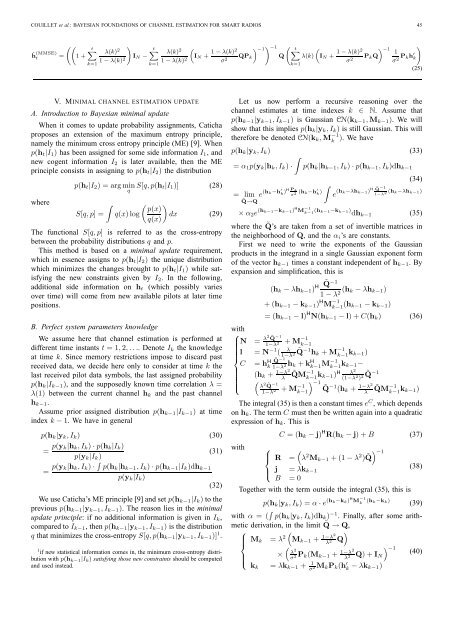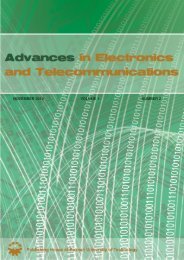channel - Advances in Electronics and Telecommunications
channel - Advances in Electronics and Telecommunications
channel - Advances in Electronics and Telecommunications
You also want an ePaper? Increase the reach of your titles
YUMPU automatically turns print PDFs into web optimized ePapers that Google loves.
COUILLET et al.: BAYESIAN FOUNDATIONS OF CHANNEL ESTIMATION FOR SMART RADIOS 45<br />
ˆh (MMSE)<br />
t<br />
=<br />
tX λ(k)<br />
1 +<br />
k=1<br />
2<br />
1 − λ(k) 2<br />
!<br />
tX λ(k)<br />
IN −<br />
k=1<br />
2<br />
1 − λ(k) 2<br />
„<br />
1 − λ(k)2<br />
IN +<br />
σ2 QPk<br />
«−1 !−1<br />
Q<br />
V. MINIMAL CHANNEL ESTIMATION UPDATE<br />
A. Introduction to Bayesian m<strong>in</strong>imal update<br />
When it comes to update probability assignments, Caticha<br />
proposes an extension of the maximum entropy pr<strong>in</strong>ciple,<br />
namely the m<strong>in</strong>imum cross entropy pr<strong>in</strong>ciple (ME) [9]. When<br />
p(ht|I1) has been assigned for some side <strong>in</strong>formation I1, <strong>and</strong><br />
new cogent <strong>in</strong>formation I2 is later available, then the ME<br />
pr<strong>in</strong>ciple consists <strong>in</strong> assign<strong>in</strong>g to p(ht|I2) the distribution<br />
where<br />
p(ht|I2) = arg m<strong>in</strong><br />
q S[q, p(ht|I1)] (28)<br />
� � �<br />
p(x)<br />
S[q, p] = q(x) log dx (29)<br />
q(x)<br />
The functional S[q, p] is referred to as the cross-entropy<br />
between the probability distributions q <strong>and</strong> p.<br />
This method is based on a m<strong>in</strong>imal update requirement,<br />
which <strong>in</strong> essence assigns to p(ht|I2) the unique distribution<br />
which m<strong>in</strong>imizes the changes brought to p(ht|I1) while satisfy<strong>in</strong>g<br />
the new constra<strong>in</strong>ts given by I2. In the follow<strong>in</strong>g,<br />
additional side <strong>in</strong>formation on ht (which possibly varies<br />
over time) will come from new available pilots at later time<br />
positions.<br />
B. Perfect system parameters knowledge<br />
We assume here that <strong>channel</strong> estimation is performed at<br />
different time <strong>in</strong>stants t = 1, 2, . . .. Denote Ik the knowledge<br />
at time k. S<strong>in</strong>ce memory restrictions impose to discard past<br />
received data, we decide here only to consider at time k the<br />
last received pilot data symbols, the last assigned probability<br />
p(hk|Ik−1), <strong>and</strong> the supposedly known time correlation λ =<br />
λ(1) between the current <strong>channel</strong> hk <strong>and</strong> the past <strong>channel</strong><br />
hk−1.<br />
Assume prior assigned distribution p(hk−1|Ik−1) at time<br />
<strong>in</strong>dex k − 1. We have <strong>in</strong> general<br />
p(hk|yk, Ik) (30)<br />
= p(yk|hk, Ik) · p(hk|Ik)<br />
p(yk|Ik)<br />
(31)<br />
= p(yk|hk, Ik) · � p(hk|hk−1, Ik) · p(hk−1|Ik)dhk−1<br />
p(yk|Ik)<br />
(32)<br />
We use Caticha’s ME pr<strong>in</strong>ciple [9] <strong>and</strong> set p(hk−1|Ik) to the<br />
previous p(hk−1|yk−1, Ik−1). The reason lies <strong>in</strong> the m<strong>in</strong>imal<br />
update pr<strong>in</strong>ciple: if no additional <strong>in</strong>formation is given <strong>in</strong> Ik,<br />
compared to Ik−1, then p(hk−1|yk−1, Ik−1) is the distribution<br />
q that m<strong>in</strong>imizes the cross-entropy S[q, p(hk−1|yk−1, Ik−1)] 1 .<br />
1 if new statistical <strong>in</strong>formation comes <strong>in</strong>, the m<strong>in</strong>imum cross-entropy distribution<br />
with p(hk−1|Ik) satisfy<strong>in</strong>g those new constra<strong>in</strong>ts should be computed<br />
<strong>and</strong> used <strong>in</strong>stead.<br />
tX<br />
k=1<br />
„<br />
λ(k) IN +<br />
1 − λ(k)2<br />
σ2 «−1<br />
1<br />
PkQ<br />
σ2 Pkh ′ !<br />
k<br />
(25)<br />
Let us now perform a recursive reason<strong>in</strong>g over the<br />
<strong>channel</strong> estimates at time <strong>in</strong>dexes k ∈ N. Assume that<br />
p(hk−1|yk−1, Ik−1) is Gaussian CN(kk−1, Mk−1). We will<br />
show that this implies p(hk|yk, Ik) is still Gaussian. This will<br />
therefore be denoted CN(kk, M −1<br />
k ). We have<br />
p(hk|yk, Ik)<br />
�<br />
(33)<br />
= α1p(yk|hk, Ik) · p(hk|hk−1, Ik) · p(hk−1, Ik)dhk−1<br />
′<br />
(hk−h<br />
= lim e<br />
˜Q→Q<br />
k )H Pk ′<br />
σ2 (hk−h k )<br />
× α2e (hk−1−kk−1) H M −1<br />
k−1 (hk−1−kk−1) dhk−1<br />
�<br />
(34)<br />
e (hk−λhk−1) H ˜ Q −1<br />
1−λ2 (hk−λhk−1)<br />
(35)<br />
where the ˜ Q’s are taken from a set of <strong>in</strong>vertible matrices <strong>in</strong><br />
the neighborhood of Q, <strong>and</strong> the αi’s are constants.<br />
First we need to write the exponents of the Gaussian<br />
products <strong>in</strong> the <strong>in</strong>tegr<strong>and</strong> <strong>in</strong> a s<strong>in</strong>gle Gaussian exponent form<br />
of the vector hk−1 times a constant <strong>in</strong>dependent of hk−1. By<br />
expansion <strong>and</strong> simplification, this is<br />
(hk − λhk−1) H ˜ Q−1 1 − λ2 (hk − λhk−1)<br />
+ (hk−1 − kk−1) H M −1<br />
k−1 (hk−1 − kk−1)<br />
= (hk−1 − l) H N(hk−1 − l) + C(hk) (36)<br />
with<br />
⎧<br />
N =<br />
⎪⎨<br />
⎪⎩<br />
λ2Q˜ −1<br />
1−λ2 + M −1<br />
k−1<br />
l = N−1 ( λ<br />
1−λ2 ˜ Q−1hk + M −1<br />
k−1kk−1) C = hH ˜Q<br />
k<br />
−1<br />
1−λ2 hk + kH k−1M−1 k−1kk−1− (hk + 1−λ2 ˜QM λ<br />
−1 H λ2<br />
k−1kk−1) � 2<br />
λ Q˜ −1<br />
1−λ2 + M −1<br />
�−1 ˜Q −1<br />
k−1 (hk + 1−λ2<br />
λ<br />
(1−λ 2 ) 2 ˜ Q −1<br />
˜QM −1<br />
k−1 kk−1)<br />
The <strong>in</strong>tegral (35) is then a constant times e C , which depends<br />
on hk. The term C must then be written aga<strong>in</strong> <strong>in</strong>to a quadratic<br />
expression of hk. This is<br />
C = (hk − j) H R(hk − j) + B (37)<br />
with ⎧<br />
⎪⎨ R<br />
⎪⎩<br />
�<br />
= λ2Mk−1 + (1 − λ2 ) ˜ j<br />
B<br />
�−1 Q<br />
= λkk−1<br />
= 0<br />
(38)<br />
Together with the term outside the <strong>in</strong>tegral (35), this is<br />
p(hk|yk, Ik) = α · e (hk−kk) H M −1<br />
k (hk−kk)<br />
(39)<br />
with α = ( � p(hk|yk, Ik)dhk) −1 . F<strong>in</strong>ally, after some arithmetic<br />
derivation, <strong>in</strong> the limit ˜ Q → Q,<br />
⎧<br />
⎪⎨<br />
Mk = λ<br />
⎪⎩<br />
2<br />
�<br />
Mk−1 + 1−λ2<br />
λ2 �<br />
Q<br />
�<br />
2<br />
λ × σ2 Pk(Mk−1 + 1−λ2<br />
λ2 �−1 Q) + (40)<br />
IN<br />
kk<br />
= λkk−1 + 1<br />
σ 2 MkPk(h ′ k<br />
− λkk−1)







